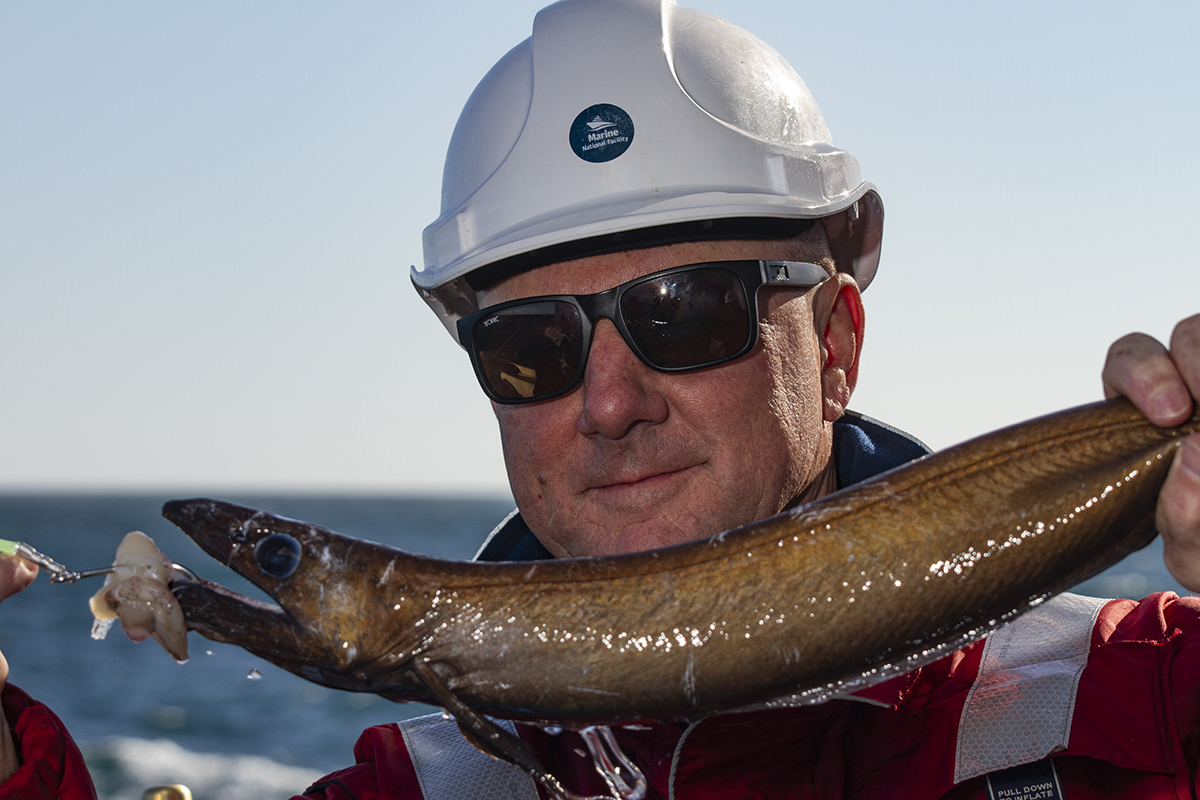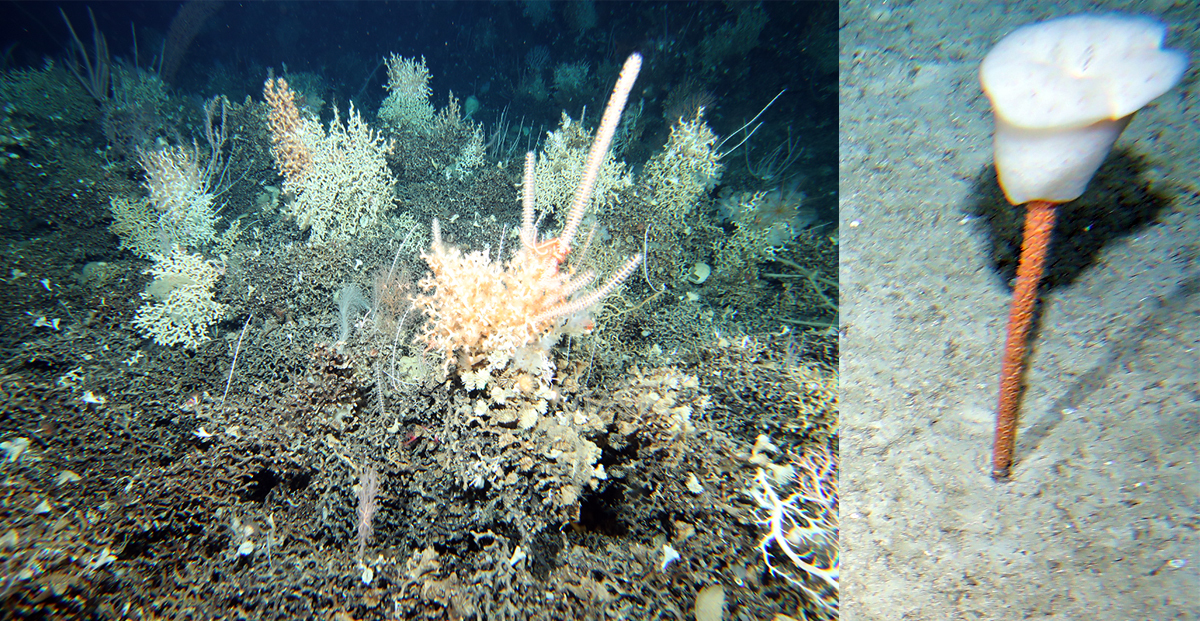December 14, 2018


Subsequent to the writing of this blog, Anoosh got the gear set up super quick for a second fishing operation after eels were spotted in a deep-camera tow. Dave Logan of Parks Australia displays the result; another female carrying eggs. Image: Fraser Johnston/CSIRO
Day 22: Mark Green, CSIRO
Science voyages down to the southern seamounts are a rare opportunity to collect information about a poorly understood fish aggregation phenomenon. Before the marine parks were made in 2007 these areas were fished by hard working commercial trawlers. They reported that large numbers of the basketwork eel (Diastobranchus capensis) were caught at Patience Seamount.
This information raised the interest of our voyage science leader, Alan Williams, and he tries to collect samples of these animals from this aggregation whenever the opportunity presents. The theory is that this is a spawning aggregation; the unusual thing is that is seems to persist all year round. Spawning aggregations occur when fish gather at a specific location or at a specific time of year in order to increase reproductive success. Few well-known spawning aggregations exist, and if they are targeted by fishermen, it can make a large impact on the local population.
It would be unlikely that individual eels are constantly in spawning condition, so it could be that eels travel into this area through the entire year, spawn and then move on. The main questions here (as indicated by Alan in the first blog of this series on 23 November) being ‘are the eels in spawning condition at this location year-round’, ‘how big is the aggregation’ and ‘is it actually persistent’. Other unknowns are, ‘what do they eat’ and ‘where do they come from’.
While acoustic methods to assess abundance (see Rudy Kloser’s blog from Day 9) could give us an answer to ‘how many?’, to try and get a handle on some of the other unknowns we need to collect some specimens. The challenge here is that the eels are in 1100 metres of water and tend to live in areas with large amounts of corals and rough bottom. This makes it difficult to collect just the eels and not the habitat.
A few eels were collected about 10 years ago, and then a few more in April 2015 using the CSIRO beam trawl. This small and relatively light scientific sampling net (compared to commercial trawl nets) is not ideal to sample rough bottom with lots of sensitive structure. So here we are again, this time armed with a heavy duty electric powered fishing rig loaded with 2000 m of 48 kilogram breaking strain braided fishing line, a 5 kg sinker, a trace with 10 hooks (baited with squid) and a beast of a rod holder to keep the rig on the ship if it gets fully loaded.


Just before we started using the rod and line, we towed the camera system over the top of the seamount and down through a ‘mark’ on the sounder that could have been the eel aggregation. The sounder indicated that most of whatever was down there was up off the bottom. The vision from the camera system showed us a few eels, but certainly not as many as we had observed in April of 2015.
The weather was perfect for fishing and the officers on the bridge engaged the dynamic positioning mode so Investigator would hold position over our target. With great expectation and a sense of excitement we sent our first hopeful batch of 10 hooks to the sea floor. The 5 kg sinker quickly dragged the hooks down to the sea floor in 10 minutes. With 1100 m of line out we were not sure if we were getting bites from these 2–3 kg eels. With high hopes, after 30 minutes we used the power reel to wind up; many eyes watching for the first glimpse of the catch. The first hook out of the water was greeted with cheers as it had caught an eel, but the other nine contained just the uneaten bait. As the sun sank below the horizon and undeterred by the first attempt, some fresh baits were sent down to try again. This time the result was single small shark. It was fully dark by this time and with a busy ship schedule of camera tows still to complete we had to abandon fishing to continue survey work.
The eel captured did reveal some important information. It was a small female that with well-developed eggs inside, indicating that it was not long from spawning. So while the aggregation seemed to be smaller than previously observed, it seems to persist into December, supporting the theory this is a year round spawning aggregation.



Notes on today's activities from Marine Biodiversity Hub Director, Nic Bax . . .
The day started with a conductity temperature depth (CTD) cast to over 2000 metres. We decided to take an extra sample of the water chemistry in this area, because of the possible impact of the Aragonite Saturation Horizon (ASH) on the depth distribution of Solenosmilia variabilis. In 2008 the ASH was at about 1050 m, meaning that water above 1050 m was 100% saturated in the form of calcium that Solenosmilia uses for building its hard skeleton and below 1050 m, the animals would find it progressively harder (ie. more energetically expensive) to incorporate new skeleton, and old formed skeleton might dissolve or thin. It has been suggested that the ASH has shoaled 150 m due to Anthropogenic climate change which could have had considerable influence on the current distribution of live Solenosmilia. On the other hand, a single sample of dead Solenosmilia collected in the 1400–1600 m range was dated at approximately 11,100 years old, so changes in water chemistry may have been taking place over a very long time.
Following the CTD we continued background tows in areas away from the main seamounts. We have become quite used to the communities by now, but even so some tows are particularly spectacular for their relief and/or the diversity and abundance of animals that we see. One clump of live Solenosmilia was observed at 1453 m depth, the deepest that we have seen it so far. We are now restricted to tows at depths of less than 1550 m, after the towed camera wire was shortened to remove a compromise section.
On one tow down the other side of the hill to that towed before, more eels were seen and it seemed worthwhile to use the rod and power reel again to try to catch an eel at 1100 m. We were again successful in catching one eel – a female with clearly developed eggs.
At a little after midnight, scientists were observed heading towards upper decks to spot the Geminid meteor shower, but it turned out to be too cloudy.
- Log in to post comments

